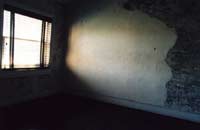Go With the Poe
Take a tour of nothing at the house where Edgar Allen once lived.
Philadelphia Weekly
June 16, 2004

-
Take a tour of nothing at the house where Edgar Allen once lived.
Photo by Adam Marnie/Philadelphia Weekly
In most museums they make you take off your backpack so you don't knock anything over. But the Edgar Allan Poe National Historic Site isn't most museums. For one thing, it's the only surviving house of the five that Poe lived in during his six years in Philadelphia. For another, you couldn't knock anything over if you tried. The Poe House, as it's commonly called, doesn't have anything in it at all.
The house has been empty since it was made part of the National Park Service in 1978, due to a lack of evidence of the kind of furnishings it might have held. But barren as it now is, the house at Seventh and Spring Garden streets is the place where Poe spent one of his most productive years. ("The Tell-tale Heart" and "The Fall of the House of Usher" are among the stories published while he lived in Philadelphia.)
The emptiness of the once-creative space captured the imagination of poet and writer Tom Devaney, who grew up in Philadelphia and is now an English professor and the program coordinator of the Kelly Writers House at the University of Pennsylvania.
Devaney spent much of the past year devoted to his Poe preoccupation, clattering around the house--where Poe lived with his teenage wife Virginia and her mother Maria--and immersing himself in Poe's work. He also concocted the Empty House Tour, an imaginative meditation on "Poe the writer and Poe the man," as Devaney puts it. He received permission from the Park Service to put on the unique program--part tour, part performance piece--as part of the current 36-institution exhibit "The Big Nothing."
On the first Empty House Tour last Saturday, Devaney led the group through the parlor and kitchen--ear-ringingly quiet rooms featuring what Devaney calls a "chaos of cracks" in the walls--and ended up, appropriately, in the spooky low-ceilinged basement. Devaney says the house's cell-like rooms have a feeling of "enclosure" that's present in Poe's stories, many of which take place entirely in one room.
But the Empty House is more a tour of Poe's imagination than of the building itself. In a second-floor room, Devaney reads the poem "Alone" as those in attendance sing a lullaby, a devotion to the musicality of Poe's poems. In Virginia's bedroom he leads the group in a meditation toward a hypnagogic state (not awake, not yet asleep), a reference to Poe's dreamlike imaginings.
National Park Service ranger Andrew McDougall, who helped facilitate Devaney's work in the house, says that this week the Park will begin discussing whether the Poe House should stay as it is, or be filled with period furnishings.
For his part, Devaney would like to see it remain empty. "It's a perfect symbol for Poe and his work," he says.
The Empty House Tour
Sat., June 19 and Sun., June 20, 2pm. Free, reservations required. Edgar Allan Poe National Historic Site, 532 N. Seventh St. 215.597.8780. www.nps.gov/edal
